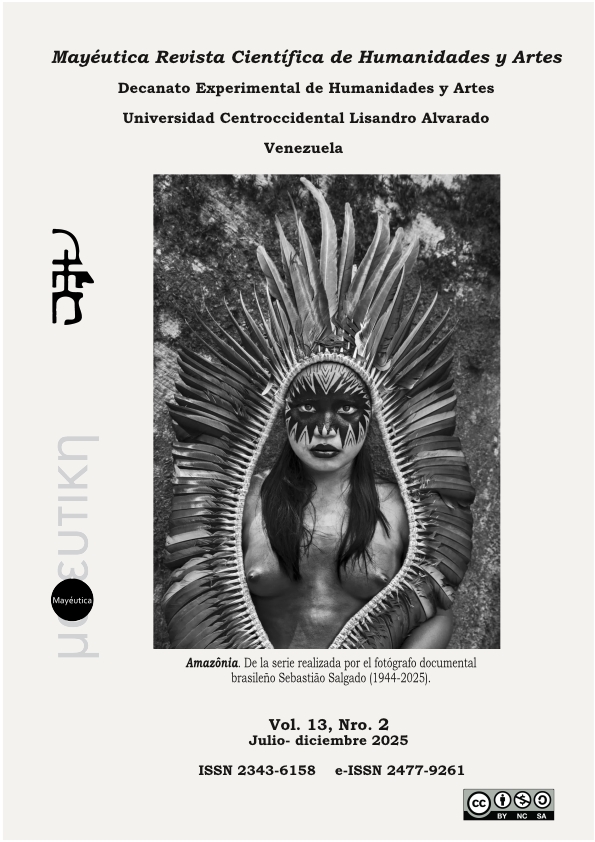Animal thinking
local intelligences and aesthetics
DOI:
https://doi.org/10.5281/zenodo.16734036Keywords:
aesthetics, animal thought, visual arts, cognitive ethology, intelligence of the territoriesAbstract
This article explores the relationship between aesthetics, art, and the animal world. To do so, it examines artists who have constructed their poetics based on animal ecosystems and the worlds surrounding them. This relationship with animal life implies a movement from representation to presentation, as the set of animal signs unfolds and inserts itself into the world of the arts. These perspectives are ecological and negentropic, as they propose a departure from the anthropocentric machine to discover the singularities of living beings with their own intelligences. Finally, we examine three artists who live in Guayaquil, who reinstate the practice of visual arts in previously unseen places. These artists explore the interaction with technology, the city's ecosystems, the extractivism inherent to the urban environment, and the lack of interspecies diplomacy that prioritizes the preservation of humans over the earth. Their proposals invite us to question our way of life and to experience the locality with its own logic, knowledge, and life solutions.
Downloads
References
Arachnophilia. (2017). Arachnophilia. https://arachnophilia.net/mappingagainst extinction/
Baranzoni, S., y Vignola, P. (2022). El tránsito, destino trágico (de lo) contemporáneo. Notas por una investigación escénica. En O. López, y A. Freire, Trágico y tránsito. Movilidades artísticas y filosóficas en las ciudades contemporáneas. Máquina Púrpura.
Coccia, E. (2017). La vida de las plantas. Una metafísica de la mixtura. Miño y Dávila.
Despret, V. (2018). ¿Qué dirían los animales… si les hiciéramos las preguntas correctas? Cactus.
Despret, V. (2022). Habitar como un pájaro. Modos de hacer y de pensar los territorios. Cactus.
Jaime, E. (22 de Agosto de 2024). Eduardo jaime. https://www.flickr.com/people/eduardojaime/
Kronfle, R. (9 de Agosto de 2018). Eduardo Jaime: Colector. https:// www.paralaje.xyz/eduardojaimeelsavantylalente/
López, O. d. (2021). Los trazos: heridas del tiempo. En O. d. López, Formas del tiempo. UArtes Ediciones.
Marginalia, B. (28 de Agosto de 2012). Messiaen Epode (Chronochromie 1959-60). [Video]. Youtube. https://www.youtube.com/watch?v=JedBQq8qGFE
Massumi, B. (2014). What Animals Teach Us about Politics. Duke University Press.
Morizot, B. (2023). Les Diplomates. Cohabiter avec les loups sur une autre carte du vivant. Wildproject.
Museo de Arte Moderno de Buenos Aires. (23 de Abril de 2020). Tomás Saraceno: El tiempo de las arañas, 2017. [Video] Youtube. https://www.youtube.com/watch? v=eFmmGtcRzFw
Pallamidessi, J. (25 de febrero de 2021). Bernie Krause – The Great Animal Orchestra. [Video]. Youtube. https://www.youtube.com/watch?v=btrinTDDjnQ
Portaluppi, M. (s.f.). Estado Paralelo. https://www.mariaportaluppi.com/estado paralelo
Preciado, P. B. (2022). Dysphoria mundo. Anagrama.
Souriau, É. (2022). El sentido artístico de los animales. Cactus.
Uexküll, J. V. (2016). Andanzas por los mundos circundantes de los animales y los hombres. Cactus.
Valdéz, A. R. (9 de diciembre de 2019). Paisaje/Territorio. Imaginarios de la selva en las artes visuales. https://www.paralaje.xyz/paisajeterritorioimaginariosdela selvaenlasartesvisuales/
Villavicencio, C. (20112022). Proyectos. http://www.cristianvillavicencio.net/00b_Proyectos.html
Yong, E. (2023). La inmensidad del mundo. Urano.
Young, L. M. (2019). Conferencia 1960. En M. Mayer, Fluxus escrito. Actos textuales antes y después de Fluxus. Caja Negra.
Zourabichvili, F. (2018). El arte como juego. Cactus.
Published
How to Cite
Issue
Section
Copyright (c) 2025 Olga del Pilar López

This work is licensed under a Creative Commons Attribution-NonCommercial-ShareAlike 4.0 International License.





